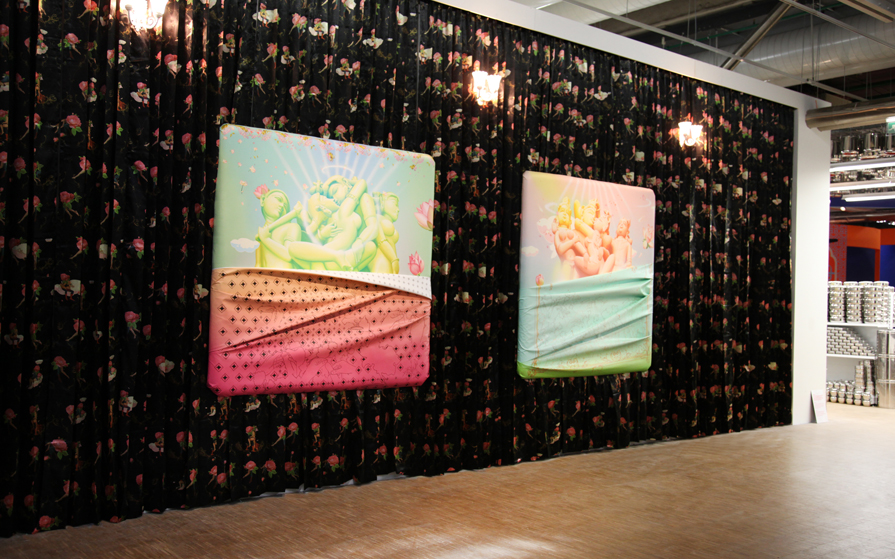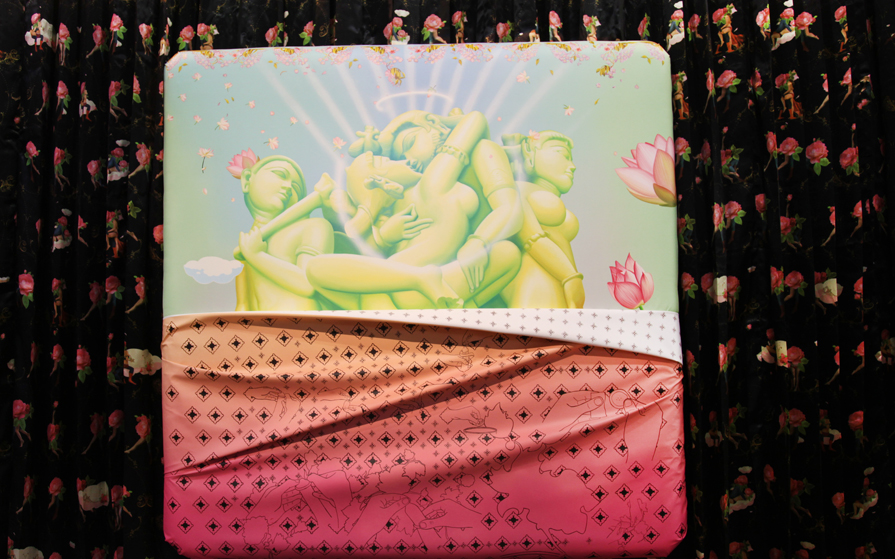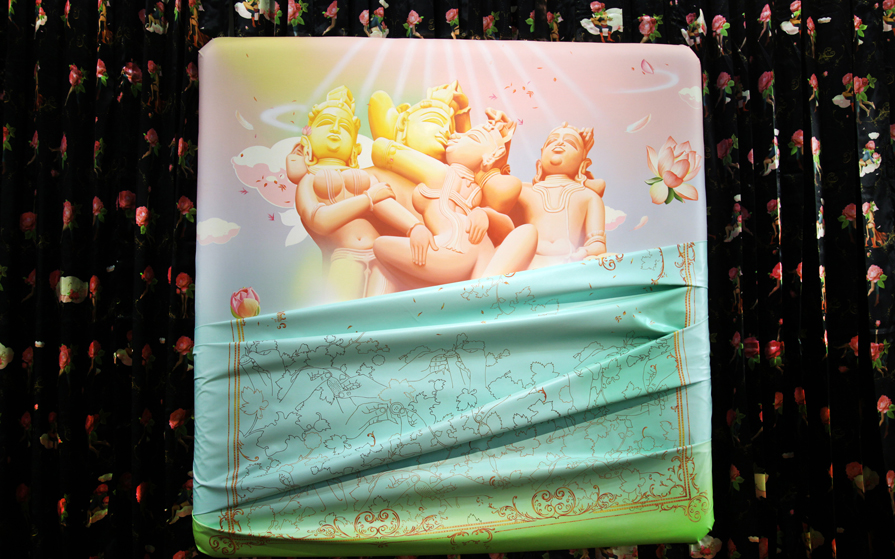Exhibitions
2024
“Arboretum at SCAD” - Savannah, Georgia, USA “Arboretum – Ebb & Flow” - Nature Morte, Mumbai2023
“Prussian Blue – Aftermath” - KNMA, Noida “Arboretum” - Nature Morte, Dhanmill, New Delhi2022
“Kochi-Muziris Biennale” - Kochi, Kerala “Pop South Asia” - Sharjah, United Arab Emirates “The Game Play – Weeping Farm + NetZero 2030” - New Delhi “Bread Winner @ 5th Biennial Contemporary Art” - Mardin, Turkey2021
“Verbal Kabaddi VII” – Waltham Forest Council - Waltham Forest Council “Conjecture” - Nature Morte, New Delhi “Farmer is a Wrestler, Lexicon of Distress” - Art at a Time Like This2020
“Kisan Mukti March” - After Hope, Asian Art Museum “Alchemist(s)” - Pearl Lam Galleries, Hong Kong “How to reappear: Through the quivering leaves of independent publishing” - MMAG Foundation for Art & Culture, Jordan
“How to Maneuver: Shape-shifting texts and other publishing tactics” - Warehouse421, Abu Dhabi “The Sundry Effect” - Bikaner House, New Delhi2019
“Bread, Circuses and I” - Nature Morte, New Delhi “Table Manners” - Palace of Independence, Astana, Kazakhstan “Lullament²” - Ludwigsburg Kunstverein, Germany “Match Fixed/ Fixed Match” - Le Tripostal, Lille, France “Double Bounce” - Pearl Lam Galleries, Singapore “Bread, Circuses & TBD” - Yorkshire Sculpture Park, United Kingdom “Farmer is a Wrestler” - Punjab Lalit Kala Akademi, Chandigarh “Lullaments” - Stir Gallery, New Delhi2018
“Collection Bureau” - IAF, New Delhi “Breaking Ground” - India Ceramics Triennale, Jawahar Kala Jendra, Jaipur “Somnium Seminibus II” - DIP Contemporary Art, Switzerland “Escape: ‘A playground of ephemerality’-Vision Exchange” - Art Gallery of Alberta, Canada “The Sculpture Park” - at Madhavendra Palace, Nahargarh Fort, Jaipur - Nature Morte2017
“Set Point_Laughing in the Vernacular” NGMA - Sakshi Gallery – Mumbai “Play, Pray” - Bikaner House, New Delhi “Bread, Circuses & You” - Art Fair, Dubai “Bread, Circuses & Wifi” - Pearl Lam Gallery, Hong Kong2016
“Walk of Life” - Level 01 - Khoj International Artists Association, Delhi
(Water) - Climate Control, The Manchester Museum, Manchester
Fed @ KCAD Galleries, Michigan “Memoir Bar” - Chatterjee & Lal, Mumbai
ABWAB - The Emotional Pavilion - Dubai Design Week, Dubai
FICA/IAF, New Delhi2015
“Walk of Life” - Of Games Residencies III - Khoj International Artists Association,
New Delhi “Games People Play” - Bhau Daji Lad Museum, Mumbai “Q : The Lighthouse” - Nature Morte, New Delhi2014
“Sparsha” - Touching the Senses, Ritual and Contemporary Indian Art”- Kunstmuseum,
Bochum2013
“Longing for Tomorrow II” - Meissen Porcelain, Residence of the German Ambassador to India, New Delhi “Q” - Famous Studios, Nature Morte, Mumbai “Windows of Opportunity” - Art Plural, Singapore2012
“Longing for Tomorrow” - Nature Morte, Berlin
“Nosturistic” - Hilger Contemporary, Vienna “Escape” - India Today Arken Museum of Modern Art, Denmark2011
“The Beautiful Game” - Thukral & Tagra Foundation - Project Booth, Art Summit,
New Delhi “Put It On, Again!” - Nature Morte, New Delhi “Escaped!… While I Was Cooking?” – Samtidigt (Concurrent) - Helsinki Art Museum, Finland
“Maximum India” - Kennedy Center, Washington DC “Indian Highway IV” - Lyon Museum of Contemporary Art, France “Paris Delhi Bombay” - Centre Georges Pompidou, Paris “Indian Highway” - Maxxi Museum, Rome “Future Pass” - Venice Biennale and Wereld Museum, Rotterdam “Science Mystery Magic” - BTAP Gallery and Tokyo Art Fair, Tokyo “Asianart: Sustain” - Nature Morte, Berlin “The Matter Within” - Yerba Buena Center for the Arts, San Francisco “German Return” - Nature Morte, Gurgaon2010
“Bosedk Project” - Richmond Art Gallery, Vancouver “Low-Tech Family Vacations” - Singapore Tyler Print Institute, Singapore “Middle Class Dreams” - Arario Gallery, Seoul “Escaped!… While I Was Cooking?” – Samdigit - Gallery 5, Kulturhuset, Stockholm “Match Fixed/Fixed Match” - Ullens Center for Contemporary Art, Beijing “Inside India” - Palazzo Saluzzo di Paesana, Turin “Urban Manners 2” - SESC Pompie, Sao Paulo “PEHNO – Put it On” - Khoj-in-Context- Public Art.Ecology, New Delhi “Khoj-in-Context” - Public Art.Ecology, New Delhi2009
“Hi! I am INDIA” - Escape for the Dream Land - Asia Pacific Triennial of Contemporary Arts 06, Queensland Art Gallery, Brisbane “Escape for the Dream Land” - Asia Pacific Triennial of Contemporary Arts 06, Queensland Art Gallery, Brisbane “Chalo! India: A New Era of Indian Art” - National Museum of Contemporary Art, Seoul; Essl Museum, Vienna “Thukral & Tagra, 315 Sector 23, Opp Bosedk Mall” - Gallery Barry Keldoulis, Sydney “Nouveau Riche” - Nature Morte, Berlin2008
“Imaginery Realities” - Max Wigram Gallery, London “Make Art Stop AIDS” - UCLA Fowler Museum, Los Angeles “Chalo! India: A New Era of Indian Art” - Mori Art Museum, Tokyo “The Audience & the Eavesdropper” - Phillips de Pury, London and New York “Somnium Genero Cafe” - Tokyo Art Fair, Tokyo “Somnium Genero 02” - Gallery Barry Keldoulis, Sydney “New Improved Bosedk” - Chatterjee and Lal, Mumbai2007
“PINK” - Galerie Mirchandani + Steinruecke, Mumbai “New Delhi New Wave” - Marella Gallery, Milan “Animamix Biennial” - The Museum of Contemporary Art, Shanghai “Everyday Bosedk” - Nature Morte, New Delhi “Put it On” - Bose Pacia, New York “Adolescere-Domus” - Art Statements, Art Basel 38, Nature2006
“Global Edit 06” - Armani Casa, Wallpaper Magazine, Milan “Vector Classics” - Alliance Francaise, New Delhi “Vector Classics” - Jehangir Nicholson Gallery, NCPA, Mumbai2005
“Art which is around and behind” - Nature Morte, New Delhi
“Iconography” - Nature Morte, New Delhi2004
“Visual Dialogue” - Hype Gallery, London




PARIS DELHI BOMBAY | 2011
The Centre Pompidou is to present a major exhibition that explores Indian society through the eyes of Indian and French artists. The fruit of an unprecedented Franco-Indian collaboration, Paris-Delhi-Bombay is intended to promote communication between the two cultures, establishing new and lasting links. Taking the form of a unique confrontation of perspectives, this pioneering project draws on the experiences and visions of creative artists: how is India seen by Indian and French artists?
More than fifty artists offer their take on the profound changes being undergone by Indian society, looking at questions of politics (the foundations of democracy, the issue of partition, the rise of the middle classes), belief (religion, spirituality…), identity (national, regional, sexual, caste…), urban development (rural exodus, growth of the megalopolis), craft production (tradition and modernity, cultural heritage and contemporary technologies) and domestic life (family, marriage, women’s emancipation, cookery…). Indian and French artists cast new light on the India of today, offering their own interpretation of this complex society. For most of the French artists invited to participate in this exhibition, their involvement in the project was what took them to India for the first time. More than two-thirds of the works were produced specifically for this event, novel contributions to a stimulating and surprising debate. With its exciting and rapidly expanding art scene, India is the largest democracy in the world, a new economic actor of the first importance on the world scene, and the second most populous country on the planet. As such, it is the object of enormous interest to French and European publics, often generating great passion, yet it remains a distant land but poorly understood. The goal of Paris-Delhi-Bombay is to bring these two cultures together through their artists, and in so doing to cast a new light on this young, fast-growing society and its dynamic contemporary art scene. Leading Indian and art historians and curators as well as sociologists, political scientists, philosophers and anthropologists from the two countries have worked together on this project, the artists too drawing on their input.
With meetings organized in France and India, several years of discussion and research have gone into developing the intellectual framework now offered to the public through the written and audio-visual documentation that accompanies the exhibition. At the same time, a major programme of lectures, performances and screenings will offer a look at certain themes in greater depth.
THREE QUESTIONS TO ALAIN SEBAN, PRESIDENT OF THE CENTRE POMPIDOU
Question : What is different about this exhibition about India?
Alain Seban : It’s a completely unprecedented project. There have been shows devoted to the contemporary Indian art scene, both in France and abroad. But to really take the measure of the phenomenon of artistic globalisation, something new was needed. That’s why, in 2007, I launched the idea of a major exhibition that would bring the contemporary Indian art scene into dialogue with the contemporary scene in France. With globalization, we are seeing not only the proliferation of centres of artistic production but also the possibility of real inter-cultural dialogue. To help promote this dialogue, to establish communications through a highly original project bringing together Indian and French artists, this was an inspiring goal.
Question : Does it form part of the “Paris” series of exhibitions?
Alain Seban : In imagining the project I was thinking of the “Paris” series of flagship exhibitions: “Paris–New York” in 1977, “Paris–Berlin” in 1978, and “Paris–Moscow” in 1979. Launched by Pontus Hulten in order “to situate Paris in the circulation of ideas,” those exhibitions effected a retrospective examination of the relations between Paris, world capital of art until the 1950s, and other centres of 20th-century artistic production, all of them in the West, culturally speaking. The idea of situating the French scene within the international circulation of ideas remains valid in this 21st century, but it has to take into account the phenomenon of artistic globalization and the advent of “emerging art scenes,” the development of contemporary art outside the West, something that the Centre Pompidou was the first to herald, in 1989, with Jean-Hubert Martin’s legendary exhibition “Les Magiciens de la Terre.” And, of course, it has to be done not retrospectively but by looking forward, helping to promote a dialogue that remains to be invented. And for this, there could be nothing better than to call on artists themselves. It is in close collaboration with the artists, and in this spirit, that we developed the idea of “Paris-Delhi-Bombay…”, an experimental exhibition that includes many works especially commissioned.
Question : Does the project represent a new direction for the Centre Pompidou?
Alain Seban : The exhibition illustrates our desire to create a global museum, and the necessity of networking if this is to be done. At the same time, this global vision is an expression of our commitment to French art, because to think globally you have to act locally. The promotion of French art is to my mind indissociable from the global ambition of the project. As an exhibition, it is also a look at a society, and in this it is faithful to another fundamental principle of the Centre Pompidou, being a way of “relating art and society.” To conclude, it is the result of four years of work, of research, of which the exhibition is the culmination. Not only an end point, but also a starting point, because the exhibition marks the inauguration of a lasting relationship between the artists involved. And is there any reason why we should not imagine repeating the experience, in future, with other national art scenes?
Related Links: www.centrepompidou.fr